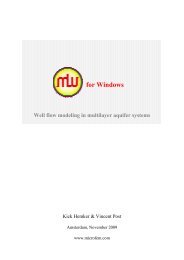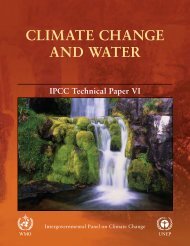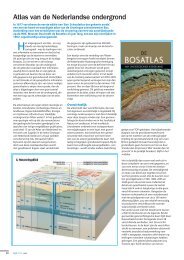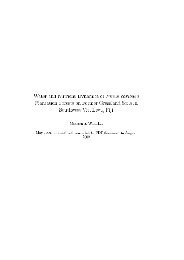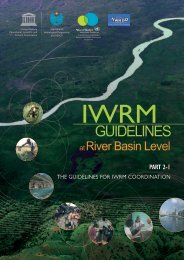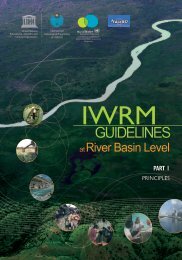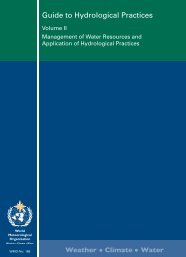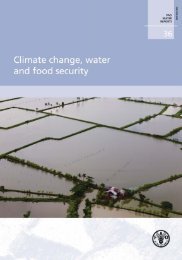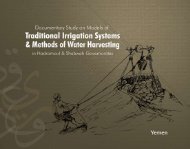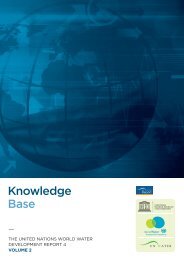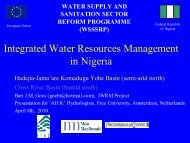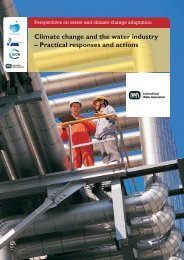Non-renewable groundwater resources: a ... - unesdoc - Unesco
Non-renewable groundwater resources: a ... - unesdoc - Unesco
Non-renewable groundwater resources: a ... - unesdoc - Unesco
- No tags were found...
You also want an ePaper? Increase the reach of your titles
YUMPU automatically turns print PDFs into web optimized ePapers that Google loves.
CHAPTER 3 ■ AQUIFER CHARACTERISATION TECHNIQUESTable 9. Summary of hydrogeological tools to guide <strong>groundwater</strong> development and managementEXPLORATION DEVELOPMENT MANAGEMENTTOOLSGroundwater useonly for ruralsubsistenceIntroductionof improved drillingand pumping technologyGroundwater level declineand possiblequality deteriorationField mappingand remotesensingDefinition ofaquifer extension/structure andpotentialrecharge areasIdentification of areas forintensive resource developmentand possible impacts of reducedaquifer natural dischargeChecking <strong>groundwater</strong>production from agriculturalcrop-use and status of naturaldischarge areasRegionalgeophysicalsurveysComplementsmapping ofsurface geologyImproves identification of moreproductive aquifer zones (includeuse of aeromagnetic techniques)Further refinement possiblebut not widely usedWaterwelldrillingExploratory forreconnaissancelevel data onhydrostratigraphyProduction wellfield constructionwith associated infrastructure(usually either for urban watersupplyor irrigated agriculture)Refining production system toprovide maximum energyefficiency; in some caseswaterwell rehabilitation andpump replacementDownholegeophysicalloggingImproveshydrostratigraphicanalysisImproves correlation betweenwaterwells and refines aquiferconceptual modelAids diagnosis of waterwell yieldand quality problems, and thusfacilitates rehabilitationGeographicalinformationsystemsAt best simplemanual databasesof geo-referencedhydrogeologicaldataGIS-based informationsystems for well recordsand aquifer data – outputwell-suited for input tonumerical aquifer modelsGIS transformed into MISfor data on aquifer productionperformance andsocio-economic indicatorsGroundwaterchemical andisotopicanalysisReconnaisanceleveldeterminationof <strong>groundwater</strong>genesis andchemical variationsMore detailed evaluation of<strong>groundwater</strong> genesis andevidence of contemporaryrechargeEvaluation of rates ofcontemporary recharge andprediction of <strong>groundwater</strong> qualitychanges threatening wellfieldsAnalyticalradial<strong>groundwater</strong>flow modelsAnalysis ofpumping test datafor estimation ofaquifer propertiesPrediction of drawdowns forwaterwell designAnalysis of causesof well deterioration andrehabilitation planningLumpedparameteraquifer models–------------------- Basic aquifer water balanceto confirm conceptual modelMass-balance type checks onissues such as ‘life of resource’or ‘bulk impact of production’Numericaldistributedparameteraquifer models–------------------- Testing conceptual modelvalidity, optimising wellfielddesign/production anddetermining potential long-termimpactsImproving operational efficiencyand evaluating long-termsustainability of wellfieldsGroundwaterdevelopmentrisk assessment–------------------- Assessment of risks of prematurefailure/quality deterioration ofwellfieldsAssessment of risks to<strong>groundwater</strong>-based economicdevelopment related toexternalities, such as changesin energy costs and crop prices37



